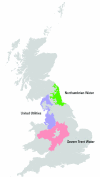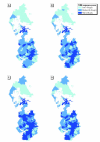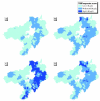Relation of trihalomethane concentrations in public water supplies to stillbirth and birth weight in three water regions in England
- PMID: 15687062
- PMCID: PMC1277869
- DOI: 10.1289/ehp.7111
Relation of trihalomethane concentrations in public water supplies to stillbirth and birth weight in three water regions in England
Abstract
We investigated the association between total trihalomethanes (TTHMs) and risk of stillbirth and low and very low birth weight in three water regions in England, 1992-1998; associations with individual trihalomethanes (THMs) were also examined. Modeled estimates of quarterly TTHM concentrations in water zones, categorized as low (< 30 microg/L), medium (30-59 microg/L), or high (> or = 60 microg/L), were linked to approximately 1 million routine birth and stillbirth records using maternal residence at time of birth. In one region, where there was a positive socioeconomic deprivation gradient across exposure categories, there was also a positive, significant association of TTHM with risk of stillbirth and low and very low birth weight. Overall summary estimates across the three regions using a random-effects model to allow for between-region heterogeneity in exposure effects showed small excess risks in areas with high TTHM concentrations for stillbirths [odds ratio (OR) = 1.11; 95% confidence interval (CI), 1.00-1.23), low birth weight (OR = 1.09; 95% CI, 0.93-1.27), and very low birth weight (OR = 1.05; 95% CI, 0.82-1.34). Among the individual THMs, chloroform showed a similar pattern of risk as TTHM, but no association was found with concentrations of bromodichloromethane or total brominated THMs. Our findings overall suggest a significant association of stillbirths with maternal residence in areas with high TTHM exposure. Further work is needed looking at cause-specific stillbirths and effects of other disinfection by-products and to help differentiate between alternative (noncausal) explanations and those that may derive from the water supply.
Figures




Similar articles
-
Use of routinely collected data on trihalomethane in drinking water for epidemiological purposes.Occup Environ Med. 2001 Jul;58(7):447-52. doi: 10.1136/oem.58.7.447. Occup Environ Med. 2001. PMID: 11404449 Free PMC article.
-
Trihalomethanes in public drinking water and stillbirth and low birth weight rates: an intervention study.Environ Int. 2014 Dec;73:434-9. doi: 10.1016/j.envint.2014.08.006. Epub 2014 Sep 20. Environ Int. 2014. PMID: 25244706
-
Total trihalomethanes in public drinking water supply and birth outcomes: a cross-sectional study.Matern Child Health J. 2014 May;18(4):996-1006. doi: 10.1007/s10995-013-1328-4. Matern Child Health J. 2014. PMID: 23884785
-
Chlorination disinfection by-products in drinking water and congenital anomalies: review and meta-analyses.Environ Health Perspect. 2009 Oct;117(10):1486-93. doi: 10.1289/ehp.0900677. Epub 2009 Jun 15. Environ Health Perspect. 2009. PMID: 20019896 Free PMC article. Review.
-
Drinking water disinfection by-products exposure and health effects on pregnancy outcomes: a systematic review.J Water Health. 2018 Apr;16(2):181-196. doi: 10.2166/wh.2018.167. J Water Health. 2018. PMID: 29676755
Cited by
-
Is fluoride a risk factor for bone cancer? Small area analysis of osteosarcoma and Ewing sarcoma diagnosed among 0-49-year-olds in Great Britain, 1980-2005.Int J Epidemiol. 2014 Feb;43(1):224-34. doi: 10.1093/ije/dyt259. Epub 2014 Jan 14. Int J Epidemiol. 2014. PMID: 24425828 Free PMC article.
-
Chlorination disinfection by-products and risk of congenital anomalies in England and Wales.Environ Health Perspect. 2008 Feb;116(2):216-22. doi: 10.1289/ehp.10636. Environ Health Perspect. 2008. PMID: 18288321 Free PMC article.
-
Birth Weight, Ethnicity, and Exposure to Trihalomethanes and Haloacetic Acids in Drinking Water during Pregnancy in the Born in Bradford Cohort.Environ Health Perspect. 2016 May;124(5):681-9. doi: 10.1289/ehp.1409480. Epub 2015 Sep 4. Environ Health Perspect. 2016. PMID: 26340797 Free PMC article.
-
Design issues in small-area studies of environment and health.Environ Health Perspect. 2008 Aug;116(8):1098-104. doi: 10.1289/ehp.10817. Environ Health Perspect. 2008. PMID: 18709174 Free PMC article.
-
Predictive model for chloroform during disinfection of water for consumption, city of Montevideo.Environ Monit Assess. 2014 Oct;186(10):6711-9. doi: 10.1007/s10661-014-3884-5. Epub 2014 Jul 1. Environ Monit Assess. 2014. PMID: 24981876
References
-
- Aschengrau A, Zierler S, Cohen A. Quality of community drinking water and the occurrence of spontaneous abortion. Arch Environ Health. 1989;44:283–290. - PubMed
-
- Aschengrau A, Zierler S, Cohen A. Quantity of community drinking water and the occurrence of late adverse pregnancy outcomes. Arch Environ Health. 1993;48:105–113. - PubMed
-
- Bove FJ, Fulcomer MC, Klotz JB, Esmart J, Dufficy EM, Savrin JE. Public drinking water contamination and birth outcomes. Am J Epidemiol. 1995;141:850–862. - PubMed
-
- Box GEP, Cox DR. An analysis of transformations. J R Stat Soc Series B. 1964;26:211–252.
-
- Carstairs V, Morris R. 1991. Socio-economic Status and Health in Scotland. Aberdeen:Aberdeen University Press.
Publication types
MeSH terms
Substances
LinkOut - more resources
Full Text Sources
Medical

